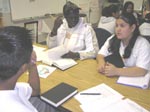
An East Oakland Odyssey
Exploring the Love of Reading in a Small School
Elena Aguilar, ASCEND. Oakland, CA
 |
|||
|
this section is still under constructionLITERATURE CIRCLESLiterature Circles are the cornerstone and foundation of my reading program. This structure has had the greatest positive impact on my student’s attitudes about reading. After using them for three years with my students, I have a wealth of data validating this claim. But my data also supports my assessment that my student’s reading skills have improved tremendously due to literature circles. Literature circles allow students choice over what they read. This choice permits them to enjoy their reading more, and thus, to learn more. In the meetings, students help each other understand the characters, plot, and vocabulary; they discuss strategies that enabled them to comprehend the book; and they personalize the novels resulting in a deep understanding. In their own reflections, my students consistently cite literature circles as profoundly impacting their reading skills. Literature circles are not the only component to my reading program. A typical “LC Cycle” lasts 2-3 weeks. I alternate LC cycles with whole class novels which I select and use to teach specific elements of literature or reading strategies, and independent reading, where students chose their own books. My primary objective for my reading program is to help students learn to love reading and to create life-long readers. Upon graduating from ASCEND, several of the students I have had for three years suggested starting a book club for alumni. A group selected a biography that they wanted to read and approached me asking if I’d like to meet with them in a month to discuss the book. I was thrilled. This is the most authentic kind of assessment I can imagine. What they learned was that literature can be fun to read and discuss. And they learned this by doing literature circles. Literature circles, however, took a long time to successfully implement. They were much more complicated and fragile than I had initially thought, and they required constant attention and management. The success of each LC cycle is different and depends on the books being read and the composition of the groups. In order for them to work to accomplish my objectives, I needed to reflect on them regularly, and to engage my students in this reflection. I knew that if I did not do this, Literature Circles could result in making reading a negative, painful experience for my students. Because Literature Circles are so personal and individual to each classroom, because they are so complicated, nuanced and fragile, I hesitate to write a “How to do Literature Circles.” There is no formula that can easily be applied and in fact, such a formula would likely result in failure. However, there are some base structures which I can share, which can be used to inspire, launch, and found a literature circle program in a classroom. The foundations for my LC program are based on Harvey Daniel’s book Literature Circles, which I urge teachers to read. I have adapted and tailored his program to fit my style of teaching and students, and then I constantly refine this program in response to the data I collect while literature circles are going on. And so use the following suggestions, handouts, and plans with great cautions, for if used haphazardly they could result in producing children who hate reading… |